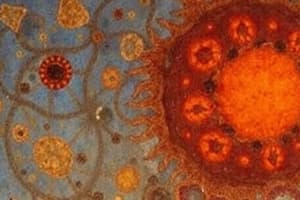Podcast
Questions and Answers
What is the main function of the nucleus in eukaryotic cells?
What is the main function of the nucleus in eukaryotic cells?
- Energy production
- Digestion of macromolecules
- Ribosome production (correct)
- Protein synthesis
Which organelle is responsible for processing and packaging proteins and lipids?
Which organelle is responsible for processing and packaging proteins and lipids?
- Rough endoplasmic reticulum
- Mitochondria
- Lysosome
- Golgi apparatus (correct)
What is the primary role of the smooth endoplasmic reticulum?
What is the primary role of the smooth endoplasmic reticulum?
- Producing and processing lipids (correct)
- Digesting cellular waste
- Synthesizing ATP
- Synthesizing nucleic acids
Which structure in the mitochondria is responsible for increasing the surface area for respiration?
Which structure in the mitochondria is responsible for increasing the surface area for respiration?
How do proteins produced in the rough endoplasmic reticulum reach the Golgi apparatus?
How do proteins produced in the rough endoplasmic reticulum reach the Golgi apparatus?
What is the structural component of centrioles involved in their function during cell division?
What is the structural component of centrioles involved in their function during cell division?
What type of enzymes do lysosomes contain?
What type of enzymes do lysosomes contain?
What provides mechanical strength and aids in cell transport and movement?
What provides mechanical strength and aids in cell transport and movement?
What is the primary role of the nucleolus within the nucleus?
What is the primary role of the nucleolus within the nucleus?
Which structure of the endoplasmic reticulum is responsible for protein folding?
Which structure of the endoplasmic reticulum is responsible for protein folding?
Which organelle produces lysosomes as part of its function?
Which organelle produces lysosomes as part of its function?
What is the composition of ribosomes?
What is the composition of ribosomes?
What type of structure do centrioles have?
What type of structure do centrioles have?
How are proteins modified in the cell?
How are proteins modified in the cell?
What do mitochondria produce that is essential for cellular functions?
What do mitochondria produce that is essential for cellular functions?
Which term describes the detailed structure of cells observed using a microscope?
Which term describes the detailed structure of cells observed using a microscope?
Flashcards are hidden until you start studying
Study Notes
Eukaryotic Cell Structure
- All living organisms are made of cells, human beings are made up of eukaryotic cells.
- Eukaryotic cells contain a nucleus and membrane-bound organelles.
- Nucleus - surrounded by a double membrane called the envelope, containing pores that enable molecules to enter and leave the nucleus. It also contains chromatin and a nucleolus, which is the site of ribosome production.
- Rough endoplasmic reticulum (RER) - a series of flattened sacs enclosed by a membrane with ribosomes on the surface. RER folds and processes proteins made on the ribosomes.
- Smooth endoplasmic reticulum (SER) - a system of membrane-bound sacs which produces and processes lipids.
- Golgi apparatus - a series of fluid-filled, flattened, and curved sacs with vesicles surrounding the edges. It processes and packages proteins and lipids, and produces lysosomes.
- Mitochondria - usually oval shaped, bound by a double membrane called the envelope. The inner membrane is folded to form projections called cristae with matrix on the inside containing all the enzymes needed for respiration.
- Centrioles - hollow cylinders containing a ring of microtubules arranged at right angles to each other. They are involved in cell division.
- Ribosomes - composed of two subunits and are the site of protein production.
- Lysosomes - vesicles containing digestive enzymes bound by a single membrane.
- Cytoskeleton - plays an important role in providing mechanical strength as well as aiding transport within cells and enabling cell movement.
Protein Transport
- Proteins are produced on the ribosomes.
- Proteins produced on the surface of the RER are folded and processed in the RER.
- The proteins are then transported from the RER to the Golgi apparatus in vesicles.
- They are then modified in the Golgi apparatus.
- The Golgi apparatus packages proteins into vesicles to be transported around the cells or where they are required.
- Some of the proteins, such as extracellular enzymes, leave the cell by exocytosis.
Cell Structure
- All living organisms are made of cells.
- Human cells are eukaryotic cells which contain a nucleus and membrane bound organelles.
- The ultrastructure of a cell can be studied using a microscope.
- The nucleus is surrounded by a double membrane called the envelope containing pores.
- The nucleus contains chromatin and a nucleolus, which is the site of ribosome production.
- The rough endoplasmic reticulum (RER) is a series of flattened sacs, enclosed by a membrane with ribosomes on the surface.
- The RER folds and processes proteins made on the ribosomes.
- Smooth endoplasmic reticulum (SER) is a system of membrane bound sacs.
- The SER produces and processes lipids.
- The Golgi apparatus is a series of fluid filled, flattened & curved sacs with vesicles surrounding the edges.
- The Golgi apparatus processes and packages proteins and lipids. It also produces lysosomes.
- Mitochondria are usually oval shaped, bound by a double membrane called the envelope.
- Cristae: The inner membrane of the mitochondria is folded to form projections.
- Matrix: The inside of the mitochondria contains matrix, which holds all the enzymes needed for respiration.
- Centrioles are hollow cylinders containing a ring of microtubules arranged at right angles to each other.
- Centrioles are involved in cell division.
- Ribosomes are composed of two sub units and are the site of protein production.
- Lysosomes are vesicles containing digestive enzymes bound by a single membrane.
- The cytoskeleton of the cell plays an important role in providing mechanical strength as well as aiding transport within cells and enabling cell movement.
Protein Transport
- Proteins are produced on the ribosomes.
- Proteins that are produced on the surface of the RER are folded and processed in the RER.
- The proteins are then transported from the RER to the Golgi apparatus in vesicles.
- The proteins are modified in the Golgi apparatus.
- The Golgi apparatus packages proteins into vesicles to be transported around the cells or to where they’re required.
- Some proteins, such as extracellular enzymes, leave the cell by exocytosis.
Studying That Suits You
Use AI to generate personalized quizzes and flashcards to suit your learning preferences.




